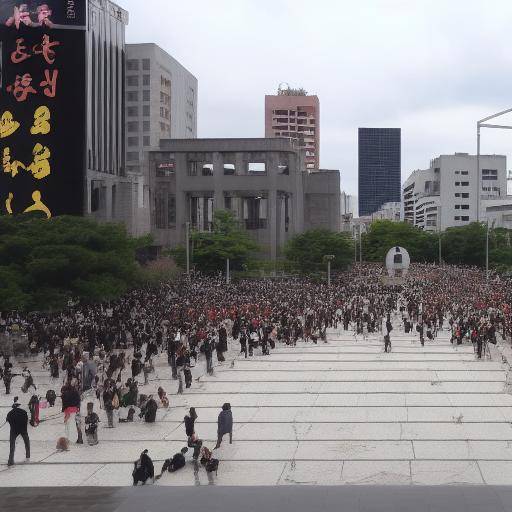
Introduction
War leaves an unforgettable impact on the memory of humanity. Hiroshima, the Japanese city devastated by an atomic bomb during World War II, hosts emblematic sites that narrate a post-war reconstruction story, commemorative monuments and a vibrant culture of peace. In this article, we will explore ten places in Hiroshima that are not only part of world history, but also living testimonies of resilience, unity and hope.
History and Background
Hiroshima, before the tragedy that catapulted her to world attention, was a rotten and prosperous city in southern Japan. On August 6, 1945, the atomic bomb launched by the United States changed the fate of the city abruptly and irreversibly. In seconds, thousands of lives were lost, and the aftermath of the attack spread over time, leaving a legacy of devastation. Post-war reconstruction, however, emerged as a beacon of hope in the midst of darkness.
Memorials
Peace and memory are intertwined in the commemorative monuments of Hiroshima. The Hiroshima Peace Memorial Park is a nerve point that pays tribute to the victims and perpetuates the desire for a world free of nuclear weapons. Here, the Atomic Bomb Dome, also known as the Genbaku Dome, stands as a tangible reminder of the terrible event. Other significant places include the Memorial of Children ' s Peace, where thousands of paper cranes testify to the longing for peace of little Sadako Sasaki, and the Hiroshima Memorial Museum of Peace, which shockingly narrates the tragedies and their consequences.
Culture of Peace
The culture of peace permeates every corner of Hiroshima, permeating the spirit of its people, artistic creativity and community initiatives. The inhabitants of the city, respectful of their past but focused on the future, are ambassadors of peace; their determination to build a better world is inspiring. The Hiroshima Peace Week, which culminates in the Fleet Lantern Ceremony, is a moving example of how the city embraces reconciliation and understanding.
Conclusion
In Hiroshima, the history of post-war reconstruction, memorials and the culture of peace are intertwined to weave a unique account of human resilience and lasting hope. The ten sites we have explored not only urge us to reflect on the horrors of war, but also remind us of the transformative potential of love, compassion and perseverance. Visiting Hiroshima is ultimately an invitation to reflection, empathy and the promise of a future based on peace.
To read more answers to frequently asked questions, go to [10 Hiroshima Sites that Count a History of Peace - Frequently Asked Questions].
Frequently asked questions
**What is the importance of post-war reconstruction in Hiroshima's history?**The post-war reconstruction in Hiroshima is emblematic, as it allowed the city to reborn from its ashes and become a symbol of peace and hope worldwide.
**What does the Memorial of Children's Peace represent?**The Memorial to Children ' s Peace represents the desire for peace and reconciliation, as well as the remembrance of the victims, particularly of small Sadako Sasaki.
**How does the culture of peace manifest itself in Hiroshima's daily life?**The culture of peace is manifested in Hiroshima through various community initiatives, festivals and artistic expressions that promote reconciliation, understanding and non-proliferation of nuclear weapons.
**Why is it important to visit the Hiroshima Memorial Peace Museum?**The Hiroshima Memorial Peace Museum offers visitors a moving and tearing perspective of the consequences of the war, as well as an opportunity to reflect on the lasting impact of nuclear weapons and the importance of working towards a peaceful world.
**What is the meaning of Hiroshima Peace Week?**Hiroshima Peace Week is a significant time in the city, commemorating the anniversary of the atomic bomb with a series of events aimed at promoting peace, reconciliation and international cooperation.
**How do the inhabitants of Hiroshima contribute to the culture of peace?**The inhabitants of Hiroshima are active advocates of peace, participating in community initiatives, promoting education on the history of the city and advocating for a world free of nuclear weapons and conflicts.
**What are some of the lessons we can learn from Hiroshima's history?**Hiroshima's story teaches us the importance of remembering the devastating consequences of war, advocating for peace and working together to prevent future conflicts and unnecessary suffering.
**How can we support peace efforts in Hiroshima and around the world?**There are many ways to support peace efforts in Hiroshima and beyond, ranging from education and awareness to participation in peace and conflict resolution organizations.
**What is the lasting impact of Hiroshima's history on the current world?**Hiroshima ' s history remains a vivid reminder of the dangers of war and nuclear weapons, and calls for a continued commitment to international peace, justice and security.
In short, Hiroshima's history is a moving reminder of the devastating effects of war, but it is also a powerful testimony of the transforming power of the human spirit and dedication to building a more peaceful world. The post-war reconstruction, commemorative monuments and the vibrant Hiroshima culture of peace offer timeless lessons and a call for action to work together towards a more prosperous and peaceful future for all.
With this, we concluded our exploration of the sites in Hiroshima that tell a story of peace.
